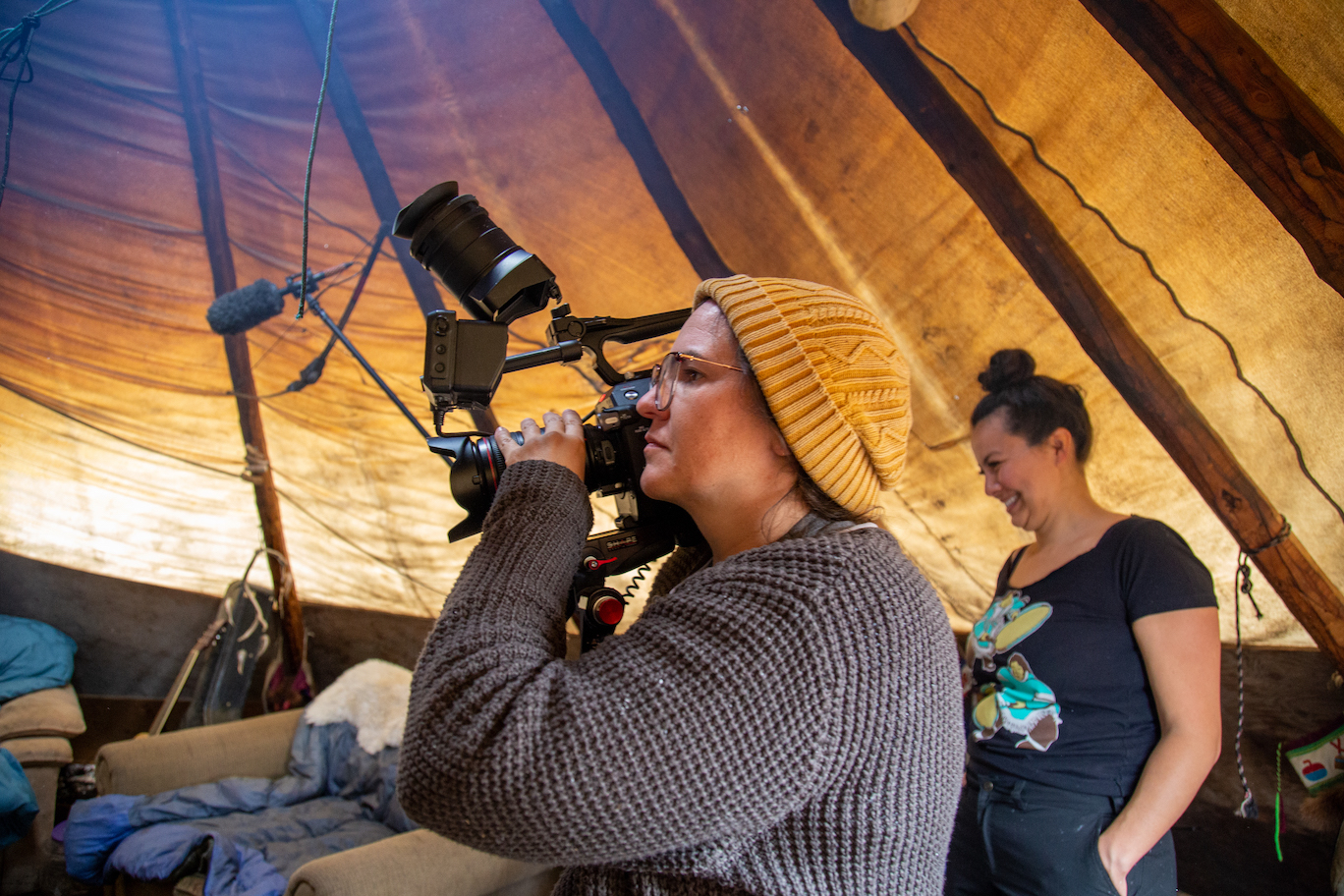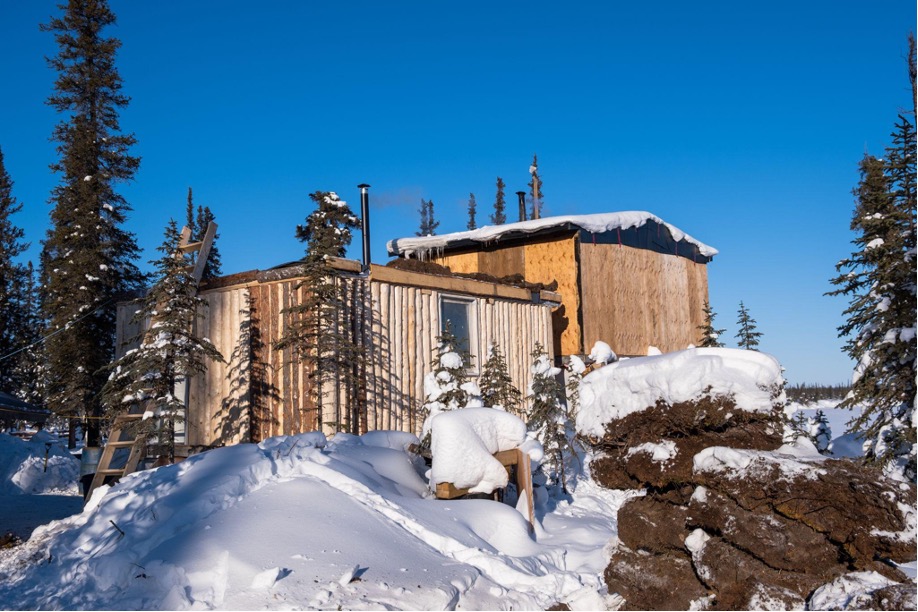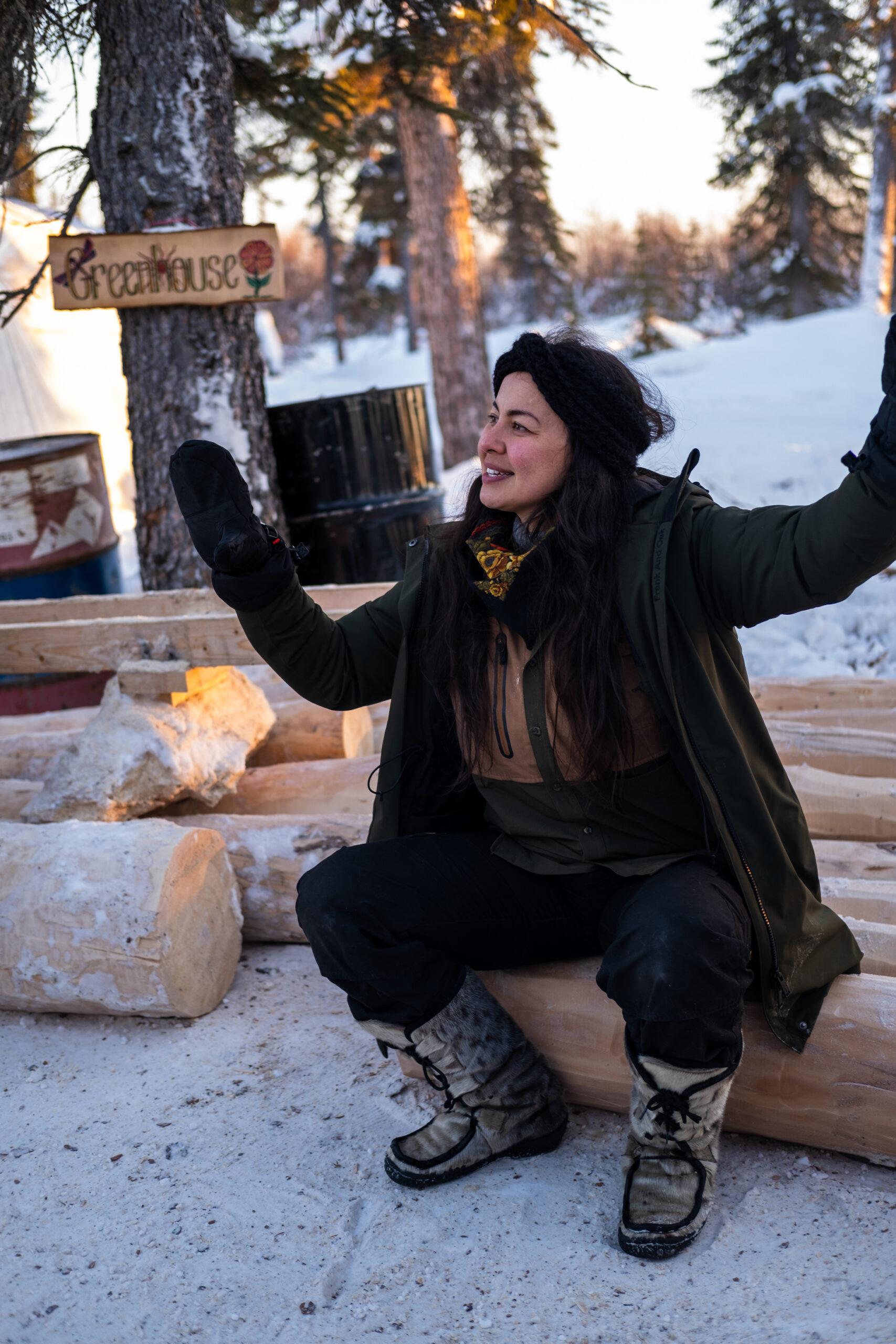Deep in the Northwest Territories, there is a town called Inuvik. Just outside is a little community run by Kylik Kisoun Taylor. Most of his family is out there. Over a year, Kylik and his daughter Indigo went hard at work to make a little community out in the sticks. Tiffany Ayalik just so happened to hear about this exciting development and had to make a documentary about it, called Okpik: Little Village In The Arctic. It’s not like the Little House trilogy, but it certainly is a story about family and how hard work gets things done.
They create everything with all the local supplies, but Kylik and Indigo keep something important in mind when developing: Traditional Indigenous knowledge. Specifically in hunting and foraging, doing what Indigenous people did MANY years ago. Bringing back long lost practices is not easy but in the end it’s all worth it. There’s lots of factors included like the Inuvialuktun language, everything about camping out there, and so much more. I talked to Tiffany about the whole process of making this stellar doc, and she went on for quite a while giving me super descriptive and amazing details.
Pack up your gear and let’s take a camping trip to Information Isle as Tiffany tells all. Don’t forget to dress warm! It’s going to be a looooong brisk night.
HNMAG: How did you get to know Kylik Kisoun Taylor and why did you choose to follow his life?
Tiffany Ayalik: I got to know Kylik Kisoun Taylor several years ago working on a different film project together. I used to host a tv show called Wild Kitchen that Caroline Cox and I worked on. She was the director and creator, I was the host for that show. The premise of that show was basically I got to travel all around the Northwest territories and meet really interesting people. They were really closely connected to their food or their foraging or trapping or fishing. We featured Kylik in one of these episodes and that’s how we first got to know each other. We went hunting for moose and for ducks and we got to see how he was living up in Inuvik and being really close to the land to finding a lot of food for his family. We really loved working with him and thought he was a cool person, doing amazing things up in the North. We stayed in touch for several years and when the pandemic hit, his touring company was hit with it and he had to liquidate his business in 48 hours. He was left with the decision to either stay in town and get a job working in an office, doing 60 hours a week at a job he hated, or he could move his family into the bush at his traditional hunting camp where he could hunt for food, chop wood to heat his house and basically live out at camp for $5 a day. He could do the things that were more culturally relevant to him. We said we would love to follow him as he created this amazing journey of living off-grid from the village with the hopes of trying to solve housing and food insecurity but also use as a model in the community at large.
HNMAG: Was he on board with this at first or did you have to discuss it?
Tiffany Ayalik: He was totally on board with it. As a company, we like to make sure that the people we’re profiling also have a high degree of sovereignty over their own story so that’s why we also made him one of the directors of the film.
HNMAG: This also focuses on what happened when the pandemic hit. What was the village like before then?
Tiffany Ayalik: There was no real infrastructure, there were some things out there but basically he erected teepees and a small shed at first. They had sort of a trailer RV they were living in at first and then that’s when they just started to think about building more infrastructure to help the village. That’s where this concept for not only making a village but creating a single unit family dwelling like his ancestors the Inuvialik did in the area, using driftwood found on the river and making a sod roof. Through this project, he was going back and reviving this practice that had been done for over 100 years.
HNMAG: And were there some problems they just couldn’t solve or did they really persevere and make it through?
Tiffany Ayalik: From a production standpoint we had lots of challenges and even just having travel restrictions for just making sure we had the proper permissions because basically the last time we went up filming. Plus we had to get COVID screening to make sure we’re not bringing COVID into the community. When he was building the village throughout the year, everyone was just having a hard time because of worker shortages. He was able to pay people, but lots of people had lots of other things going on so there were a lot of challenges but they persevered and took their time to do what they could. Also things are a lot harder out there in the North. When it’s -40 and you have to be out there building, it takes longer. They had to do a lot of ingenuity and quick thinking to solve problems.
HNMAG: How did you find ways to balance the job of directing between yourself and Kylik?
Tiffany Ayalik: We had a really good time figuring that out actually. Kylik has been in front of the camera a lot, he’s done different projects for CBC, reality stuff, so he’s been around a film crew before. We talked lots about the concept and what we wanted it to look like and feel like. There was a great deal of input from him in the planning stages and what was going to be captured. I had my own artistic style to what he was thinking of. Because I’m also a musician, actor, and storyteller, I was able to infuse my vision to compliment what Kylik wanted to execute in a really artistic way and having experience of directing lots of things, we had a really complimentary skillset.
HNMAG: I understand you directed, produced, and also worked lead sound on this. How would you describe the balancing out of all these jobs?
Tiffany Ayalik: It was such a huge learning curve. I’ve been working as a voiceover artist and voice actor for a long time. In the pandemic, I got into a lot of audio books, so I’ve been narrating things all pandemic and reading lots of books and I’ve done lots of other voiceover work. In terms of Kylik’s voice in Inuvialuktun, we did the Inuvialuktun version in the language as well as the original English version. I’ve been in front of the microphone before but I was also able to get a really great mentor to help with the technical aspect. He was setting me up with my own little mobile studio and how to use all the sound equipment.

Tiffany told me she went up to Inuvik early in June and said that everybody who spoke in the film, got lines in Inuvialiktan even if they weren’t fluent. Tiffany worked with dialect coaches, language coaches, and translators. She called it an incredible experience. Learning a rare language and adding it to the film was a nice touch.
HNMAG: Why did you have releases in 2 different languages?
Tiffany Ayalik: We were able to get some funding from the Canadian Media Fund through an Indigenous stream as well. One of the stipulations that I think is really great is you need to provide a version that is 100% in an Indigenous language and it’s a priority that film gets funded first. We also brought in Kylik’s daughter Indigo, who we used to create simple language tutorials to encourage people to keep speaking the language.
HNMAG: You also brought in new emerging Indigenous talent. Are these people from the village itself or how did you find them?
Tiffany Ayalik: We’re based in the North and we like to keep our finger on the pulse of who’s doing what up there. Working with amazing musicians like Diego Wolfe, who made some absolutely stunning music for us and he’s so grounded in the North. He knows the sounds and feels of the North. He spent a lot of time in Inuvik as well so it was great to have him. We were also able to work with Benjamin MacGregor, another Inuvialit person who is an amazing young emerging filmmaker. He got to be one of our camera operators and he was so great to work with. It was great for him to come back to a community where he has lots of family, to have as many Indigenous people both behind and in front of the camera. Then it was also hiring local people who were interested in learning how does a professional film set work. We had another sound guy, Nolan Rainbow also join us. He did really great work as our sound recorder.
HNMAG: And what kind of sound did you incorporate into this documentary?
Tiffany Ayalik: We were trying as much as possible to capture the local kind of feel and a huge part of that is the sound of what -40 sounds like in the Arctic (laughs). We tried to capture with our boom and sound equipment as much of the organic environment as possible along with the really great things people are saying. We’re just trying to paint this picture sonically and emotionally with what this village is like.
HNMAG: And your producer Caroline Cox worked as the only crew member on site in the location. How did you two keep in touch in order to communicate so she could get what you were looking for?
Tiffany Ayalik: In some cases, she would spend about two weeks out at camp with her camera and we talked a lot. Thankfully the village is far enough out of Inuvik but not so far that it isn’t intermittent cellphone service (laughs) so we were still able to keep in touch over the phone and just talk about what was happening at the camp and Kylik was also able to be providing some direction. COVID has forced us to find many other plans of communication.
HNMAG: It also must’ve been pretty cold out there. What did Caroline do to prepare for staying there and how long did she stay?
Tiffany Ayalik: Sometimes she was up there for two weeks at a time, and sometimes it was -30 or -35, but Carol’s an adopted Northerner so she’s been living in the North for a long long time. She actually has a home that’s off grid in the Northwest Territories on a homestead outside Yellowknife.

While Caroline wasn’t involved in the interview, I certainly got the jist that she knew how to prepare for such a cold climate in a remote location, and I’m certainly impressed at how much she managed to do out there.
HNMAG: So it wasn’t much of a challenge doing so much work out there for so long?
Tiffany Ayalik: That’s the kind of work that we love doing. We have lots of wilderness and outdoor-kind of adventure backgrounds. Also our film backgrounds, so we’re able to really bridge those things together to provide this skillset needed to tell these more remote and isolated stories. That would be really challenging for a Toronto crew.
HNMAG: How about editing? When you got everything you needed, was it easy to sort it all out?
Tiffany Ayalik: The thing with making docs is you plan and plan, you prepare and you think you know what the story is going to be. Then you get up there, and then the film gods can decide they’re going to throw something at you completely different, then you need to be flexible and ‘follow the puck’. Sometimes you have to be open to being spontaneous. We had tons and tons of really amazing footage, and really interesting stuff, but weren’t sure if it was part of the story we wanted to tell. As you’re wading through mountains of footage, you really start to see a theme occurring. You just start to see what the story could be and what you planned it to be. Editing a doc is really time-consuming and we worked with two amazing editors who I had worked with before and it was a lot of back and forth endless Zoom calls.
HNMAG: Was there anything you wanted to include, but had to leave out?
Tiffany Ayalik: I think that with our team, we had a really good sense of what needed to stay. CBC has very specific rules for length and everything, so you just keep on asking if something in the doc is moving the story forward or not. I feel great that everything I wanted included is in the film.
HNMAG: Have you made other Indigenous documentaries before?
Tiffany Ayalik: The last project that we worked on was called Food For the Rest of Us. It wasn’t Indigenous but since I’m an Indigenous producer, what I create is Indigenous content (laughs). We followed four different stories of people from across North America who are using food and farming as a form of activism. That was born out of our original work of Wild Kitchen, and seeing this food movement. Showing that food is an amazing tool for our autonomy. We started in an Inuit community, and then the film took us to Hawaii, to Kansas City, to Colorado.
HNMAG: And do you plan to make more documentaries like this one?
Tiffany Ayalik: It’s always an option, we have a couple more things that are in development. We’re just trying to see where they can go, but I feel like a quote-unquote Indigenous Documentary because what counts as Indigenous documentary, the subject matter, it’s an interesting concept.
HNMAG: With this one, what are you hoping people will learn from it or even take away from it?
Tiffany Ayalik: I’m hoping that people will take away the incredible power that film can be the presence of Indigenous people telling their own stories in front of and behind the camera. There’s been a lot of films shot and produced in the North, but not by a lot of Indigenous people with our own voices. I’ve been asked to be in countless Southern productions in the North, that aren’t produced, directed, or even ACTED by some Northern people. We have such an amazing capacity for storytelling, points, different ways of looking at the world, and stories. I’m really excited that this is a huge Indigenous team that we’re working with and that there’s something different that happens when we get to tell our own stories in our own voices and own ways. Hopefully we see a shift in the media landscape with our stories and that’s going to be the new normal.

With a lot of luck, and perseverance, I’m sure there will be lots more Indigenous stories told by Indigenous people and that is sure to be the new normal. I see lots of them at film festivals, but sometimes I feel like I need to see more. It’s a big desire of mine if I’m honest. For now, keep an eye out for this Okpik: Little Village in The Arctic, as it is sure to astound.
Watch one of the versions, or maybe even both as they’re coming out super soon. Today, the Inuvialuktun version premieres on CBC Gem, and tomorrow the English version premieres on CBC Manitoba.

